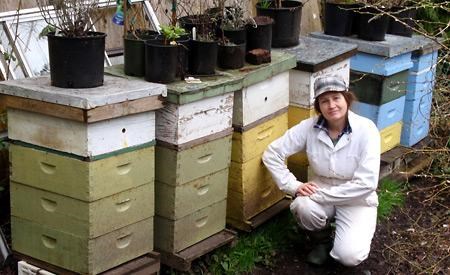To bee or not to bee was never a question for Rhonda Johnston, 53, of Texada Island. As a young child in North Burnaby, Johnston distinctly remembers the day a bee landed on her arm. “She wiggled her antennas in the air, as if to say ‘look at me, I can fly.’ The bee looked at me and I looked back and I’ve loved bees ever since.”
She says Texada is an ideal place to raise bees because it has no pollution or bee diseases, few horticultural chemicals and it’s “100 miles from the US and that country’s questionable agricultural practices.” In early 2008, wanting to encourage new beekeepers, Johnston started the Texada Bee Club, which has a dozen members, from teens to seniors.
Johnston studied biology and geology at Douglas College in New Westminster, and also insect biology at Simon Fraser University. She developed an extensive collection of insect specimens, both local and imported under licence, which she took to many elementary schools in the 1980s and 1990s. Known as the “bug lady,” she also began raising bees at a 10-acre plant nursery near Bear Creek Park in Surrey.
After meeting her husband, Ben De Grandpre, in 1992, the two moved to Roberts Creek, where Johnston kept “a couple of hives.” At the urging of De Grandpre’s father, who lived on Texada, the couple moved to the island in 1994. “I loved the fresh air, organic agriculture and no bears. Here, we have the freedom to go and do what we want.”
Johnston purchased her bees from the bee inspector in Powell River and her apiary is registered with the BC ministry of agriculture. At her half-acre Van Anda property, she keeps six colonies, or hives, which spend the winter in specially-designed “bee houses,” made to simulate the shelter of hollow logs. They are made of recycled materials and placed on wooden blocks on the ground to guard against moisture, ants and mice. They guard against the wind and rain and have ventilation. One hive lives in each house, producing about 10 honeycombs annually. During the winter, they feed on mixtures of their own honey, Crisco, sugar and chamomile tea.
Last year, with the help of her husband and two teenage daughters, Johnston’s bees produced 235 pounds of honey, mainly from three hives which spent the summer at an organic farm above Gillies Bay. “This was in addition to more than 500 pounds for the bees to eat over winter. Different hives have different honey production, depending on the number of bees and their proximity to good flowers. You need a mix of flowers within a mile radius of the hive for the best honey. April is when we see the big increase in the bee population, because of the increase in flowers and the typically sunnier, drier weather.”
Johnston says she’d rather hang out with bees than with people. “Bees are sociable. When they get used to you, you can handle them with your bare hands. They’re curious to see what they can bring back to the hive.”
Most bees are females, with males produced in the summer for mating purposes. About 95 per cent of a hive’s population are worker bees which collect water, nectar, pollen and plant resin, five per cent are drones, which keep the hive warm at night, and there is one queen. There are typically 50,000 bees in one hive, which, when clustered, are about the size of a basketball.
Johnson raises two species of bees: Red Hawaiians, which are relaxed and friendly, and New Zealand Golds, which are hard workers from a climate like ours. She also encourages local bees, including mason, leafcutter, digger and caterpillar-hunting bees.
Beekeeping, she says, is an “obsessive hobby. Bees give us a sense of optimism, they radiate happiness. They help the community by providing pollination, which is necessary for agriculture. They produce honey and beeswax, used for candles and cosmetics. Natural honey is delicious and, unlike pasteurized honey, has all its nutrients.”
This year should be a “fantastic, abundant year for honey,” Johnston says, because of the late, rainy spring which should lead to increased flowers. “Texada beekeepers are not normally ambitious producers. Mostly, we’re glad to put honey on our own tables, with a bit to sell at the island Farmers’ Market,” she said. “We’d like to see everyone produce their own honey and grow their own food.”
Her advice to readers: “Plant flowers and food plants and the bees will help bless us all.”



